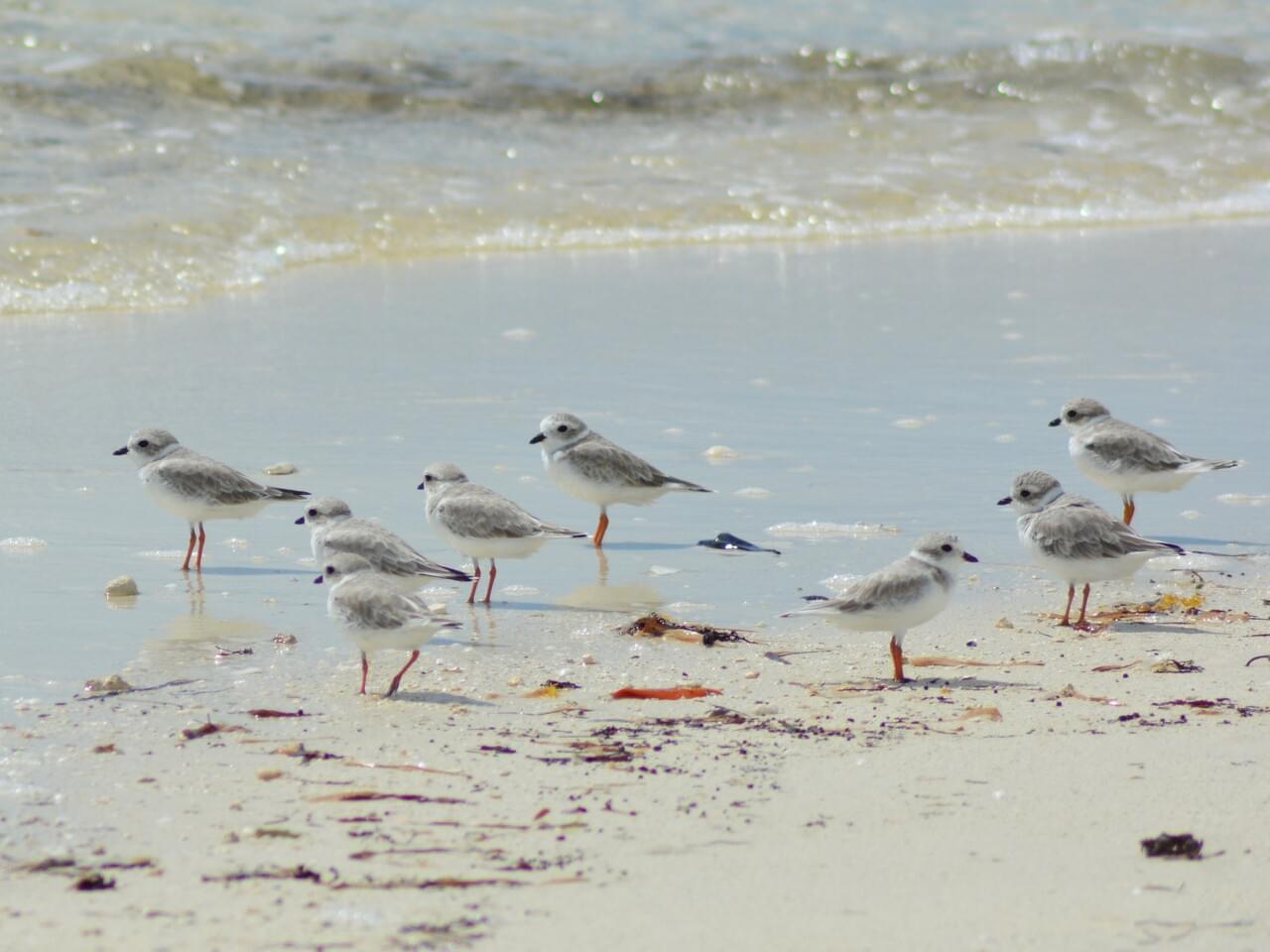Friday, May 20th is National Endangered Species Day. Many remarkable creatures inhabiting our local environment are at risk of disappearing forever. This is an unfortunate reality for several Long Island wildlife species. Let’s learn about some of these vulnerable reptiles, amphibians, birds, and insects and how we can help them continue to call Long Island home.
But first, let’s define some important terms. What does endangered mean? The New York State Department of Environmental Conservation (NYSDEC) defines endangered as “any native species in imminent danger of extirpation or extinction in New York State.” Extinction means no longer living or existing anywhere, whereas when a species is extirpated, it is locally extinct. So, there are no populations left in New York, but the species is still found in other states. Finally, when a species is listed as threatened, it is likely to become endangered in the near future.
Now let’s look at some of the unique Long Island wildlife that are in danger of being lost to history.
Endangered Species
Eastern Tiger Salamander (Ambystoma tigrinum)
This amphibian spends the majority of its life in its burrow underground, but it comes out at night to breed in ponds. In New York State, the Eastern Tiger Salamander is found exclusively on Long Island, mostly within the central Pine Barrens. Recent surveys have identified only 90 breeding ponds in eastern Nassau and Suffolk County. This mole salamander has been extirpated from western Long Island because of heavy development resulting in loss of habitat. Additional threats to this species include pesticide contamination and introduction of predatory fish in its breeding ponds as well as increased road construction and development. There has been a recent effort to construct tunnels under roadways for this salamander, so it can safely migrate to ponds for breeding. You can help this wonderful amphibian by not using pesticides on your lawn or in your garden – try a natural alternative to avoid contributing to contamination of ponds and waterways.
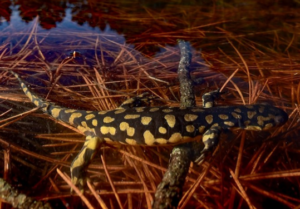
Eastern Tiger Salamander
Credit: Alex Roukis
Eastern Mud Turtle (Kinosternon subrubum)
This small hard-shelled reptile only measures 3-4 inches long! This semi-aquatic turtle can be found in marshes, small ponds, wet ditches and fields, and offshore islands. When its habitat dries up, it travels on land to another body of water. This short journey could land this turtle in trouble – turtles are very often killed by cars when attempting to cross roads. Other threats to the Eastern Mud Turtle include habitat loss due to the draining of wetlands for urban and industrial development, land clearing, habitat fragmentation from road construction, and the illegal pet trade. The NYSDEC recommends habitat management activities, such as placing “turtle crossing” signs along roads to warn drivers as well as protecting areas where mud turtle populations currently reside. Help protect the rarest turtle species in New York by looking out for this creature when you’re driving and avoiding keeping it as a pet.

Eastern Mud Turtle
Credit: animalspot.net
Piping Plover (Charadrius melodus)
You can find this sand-colored shorebird on Long Island’s sandy beaches from Queens to as far east as the Hamptons. From early to mid-March, this species starts breeding and building nests in preparation for laying eggs between May and early July. Unfortunately, the Piping Plover is continually threatened by increasing human activity. Coastal development, recreational activities, and disturbance by off-road vehicles all compromise its breeding habitat. These problems are not exclusive to New York State; this bird is listed as endangered in many other eastern states as well. You have probably seen signs and fencing surrounding the dunes at your local beach. These serve to protect this bird’s nesting and feeding sites. Long Island conservation efforts also include annual censuses of the plover’s breeding colonies and active monitoring of its nesting sites to help increase nesting success. Help protect this bird by keeping off the dunes during the spring and summer seasons, or even become a volunteer to assist with yearly breeding surveys.
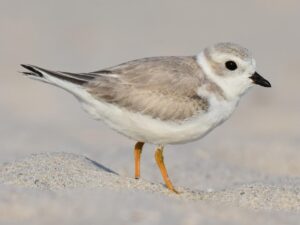
Piping Plover
Credit: AllAboutBirds.org
Hessel’s Hairstreak (Callophrys hesseli)
This butterfly species is rather unique because it feeds only on the Atlantic White Cedar tree. Unfortunately, the Hessel’s Hairstreak is believed to be extirpated from New York State as it has not been observed since the mid-1990s. Spraying of harmful pesticide DDT (dichloro-diphenyl-trichloroethane) in the 1950’s for gypsy moths wiped out many colonies and the population is still struggling to recover. In addition, much of its Atlantic White Cedar swamp habitat has been converted to agricultural land. It is important to protect what is left of these swamps as well as maintain cedar tree populations in order to help safeguard this beautiful butterfly.
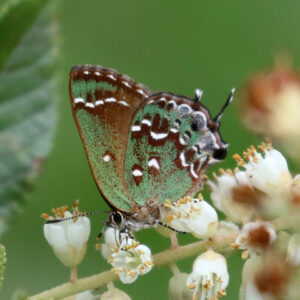
Hessel’s Hairstreak
Credit: butterfliesandmoths.org
Threatened Species
Pine Barrens Bluet (Enallagma recurvatum)
This damselfly (smaller than a dragonfly) inhabits coastal plain ponds in our very own Pine Barrens! Just one inch long, the Pine Barrens Bluet lives only three to four weeks. Threats to this species include anything that leads to water pollution, like roadway or agricultural run-off, eutrophication and nutrient loading from fertilizers, herbicides, and septic systems, or development near their habitats. Invasive plants, like the white water lily, that are replacing native plants are an additional risk to the bluet population. To combat the decrease in bluet numbers, the New York Natural Heritage Program suggests restoring native vegetation as well as maintaining good water quality by reducing run-off and other sources of pollution.
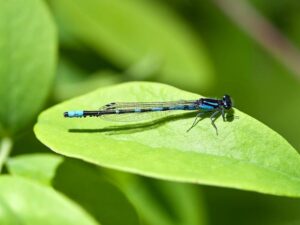
Pine Barrens Bluet
Credit: New York Natural Heritage Program
Northeastern Beach Tiger Beetle (Cicindela dorsalis dorsalis)
This cool insect gets its name from its aggressive predatory behavior – it grasps prey with long mandibles (mouthparts) in a “tiger-like” manner. This species feeds on lice, fleas, and flies as well as scavenges dead crabs and fish. This beetle used to be very common on Long Island beaches, but unfortunately it is no longer found anywhere in New York State. The only known population north of Maryland is on Martha’s Vineyard. The depletion of its population is attributed to habitat degradation by off-road vehicle use and increased foot traffic on beaches. Larvae are deeply affected by these activities because they are crushed by the heavy physical impact. Without larvae, the Northeastern Beach Tiger Beetle isn’t be able to produce enough individuals to ensure its long-term survival. The NYSDEC recommends translocating beetles from other areas, like the Chesapeake Bay, to help restore the species in its historical range. However, current beach activities will need to be addressed prior to this effort.
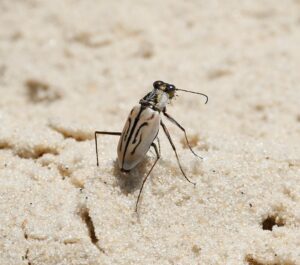
Northeastern Beach Tiger Beetle
Credit: chesapeakebay.net
There are so many neat species on Long Island that we may not be able to see for much longer. These animals are part of what makes our island such a unique place to live. Help protect these remarkable creatures by avoiding animals while you are driving, using natural alternatives to pesticides, and being more aware of the environment around you. Consider becoming a volunteer in your local community to support the recovery of the populations of these species.
By: Kaitlyn Sherman, Long Island Pine Barrens Society
Sources:
https://www.dec.ny.gov/animals/7494.html
https://guides.nynhp.org/hessels-hairstreak/
https://guides.nynhp.org/pine-barrens-bluet/
Cover photo: A group of piping plovers on the beach. Credit: AllAboutBirds.org

